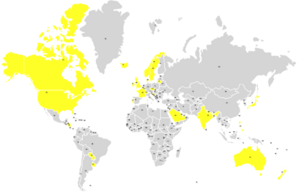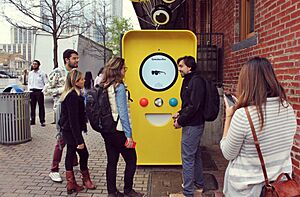Snapchat facts for kids
 |
|||||
| Original author(s) |
|
||||
|---|---|---|---|---|---|
| Developer(s) | Snap Inc. | ||||
| Initial release | September 2011 | ||||
| Stable release(s) [±] | |||||
|
|||||
| Preview release(s) [±] | |||||
| Operating system |
|
||||
| Available in | 37 languages | ||||
|
List of languages
English, Arabic, Bengali, Danish, Dutch, Filipino, Finnish, French, German, Greek, Gujarati, Hindi, Indonesian, Italian, Japanese, Kannada, Korean, Malay, Malayalam, Marathi, Norwegian, Polish, Portuguese, Punjabi, Romanian, Russian, Simplified Chinese, Spanish, Swedish, Tamil, Telugu, Thai, Traditional Chinese, Turkish, Urdu, Vietnamese
|
|||||
| Type |
|
||||
| License | Proprietary software | ||||
Snapchat is a popular app for sharing photos, videos, and messages. It was created by a company called Snap Inc.. A main feature of Snapchat is that pictures and messages, called "snaps," usually disappear shortly after they are viewed.
The app has grown a lot. It started with sharing photos between friends. Now, it also has "Stories" where users can share content for 24 hours. There's also "Discover," which lets different brands show short videos. Snapchat also lets you save photos in a private area called "My Eyes Only."
Evan Spiegel, Bobby Murphy, and Reggie Brown, who were students at Stanford University, created Snapchat. It's known for being one of the first social media apps made just for phones. It also uses fun virtual stickers and augmented reality (AR) effects. In 2023, Snapchat had over 300 million people using it every month. In 2020, more than four billion Snaps were sent each day. Snapchat is very popular with young people, especially those between 18 and 24 years old.
| Top - 0-9 A B C D E F G H I J K L M N O P Q R S T U V W X Y Z |
How Snapchat Started
Early Days
The idea for an app where pictures disappear came from Reggie Brown. He shared it with Evan Spiegel, who had some business experience. Then, they asked Bobby Murphy, who knew about coding, to join them. The three worked together and launched the app as "Picaboo" on July 8, 2011, for iOS phones.
The app was relaunched as Snapchat in September 2011. The team focused on making it easy to use and fixing technical parts. They kept a mascot designed by Brown, a ghost named "Ghostface Chillah."
In September 2014, Reggie Brown was recognized as one of the original creators of Snapchat.
In May 2012, Snapchat's CEO, Evan Spiegel, explained the app's goal. He said Snapchat was not about taking perfect pictures like old cameras. Instead, it was about sharing all kinds of feelings. He felt that social media often made people stressed about how long their photos stayed online. Snapchat was meant to solve this problem.
Growing Popularity
By May 2012, 25 Snapchat images were being sent every second. By November 2012, users had shared over one billion photos on the iOS app. About 20 million photos were shared daily. Snapchat also became available for Android phones on October 29, 2012.
In June 2013, Snapchat released a new version for iOS called "Banquo." This update made the app faster and easier to use. It added features like swiping to move around and tapping twice to reply. At the same time, Snapchat launched Snapkidz for users under 13. Snapkidz let children take and draw on snaps, but they could not send them to others. They could only save snaps on their device.
By May 2015, Snapchat users were watching 2 billion videos every day. This number grew to 6 billion by November of that year. By 2016, Snapchat reached 10 billion daily video views.
In September 2016, Snapchat Inc. changed its name to Snap Inc.. This happened when the company launched its first hardware product, Spectacles. These are smartglasses with a camera that can record 10-second videos. Spectacles became available to buy online in February 2017.
In February 2017, Snapchat had 160 million daily active users. This grew to 166 million by May.
In November 2017, Snapchat changed its design. Many users did not like the new look. For example, sending a snap and re-watching stories became more difficult. Stories and incoming snaps were on the same page. Also, the Discover page started showing more sponsored content. In December 2019, Snapchat was named the fifth most downloaded mobile app of the past ten years.
In November 2020, Snapchat announced a program called Snapchat Spotlight. It paid users who posted popular videos. The company later changed this to pay "millions per month" to creators. This program is still active.
In June 2022, Snapchat launched Snapchat Plus, a paid subscription. It gives users early access to new features, like changing the app icon and seeing who rewatches their stories. By July 2022, Snapchat had 347 million daily active users. In August 2022, Snapchat Plus had over 1 million subscribers.
In February 2023, Snapchat launched "My AI," a chatbot for Snapchat+ users. It is like a mobile version of ChatGPT. By April 2023, this customizable chatbot became available to all users and could be used in group chats. In June 2025, Snapchat released an app for the Apple Watch.
How Snapchat Works
Main Features
Snapchat is mostly used to create "snaps." These can be photos or short videos. You can add filters, effects, text, and drawings to them. Snaps can be sent privately to friends or shared with a "Story" that your friends can see. There's also a public "Our Story" for everyone.
You can record a video up to ten seconds long by holding down the photo button. Later updates allowed recording up to 60 seconds, but still in 10-second parts. Videos disappear after one viewing. In May 2014, Snapchat added video chat. You can also send text messages that disappear. You can save important information by tapping on it.
Private photo snaps can be viewed for a time you choose (1 to 10 seconds). After that, they disappear. Snapchat tells the sender if someone takes a screenshot of their snap. You can replay one snap per day for free.
You can add friends using their usernames, phone contacts, special "Snapcodes," or by using "Add Nearby" to find users close to you. Evan Spiegel said Snapchat helps people communicate without feeling pressured to create a perfect online identity.
In November 2014, Snapchat added "Snapcash." This feature let users send and receive money through private messages.
In July 2016, Snapchat introduced "Memories." This lets you save snaps and story posts in a private area. You can view them later, edit them, and share them again. When you share an old memory, it used to have a white border to show it was old, but this was removed in April 2017. Memories also have a "My Eyes Only" section, which is locked with a Personal identification number (PIN) for extra privacy.
In May 2017, an update allowed sending snaps with unlimited viewing time. The content disappears only when the person closes it. New tools were also added, like drawing with emojis and videos that play in a loop.
In July 2017, Snapchat let users add links to snaps, directing viewers to websites. This was previously only for brands. More creative tools were added, like "Backdrop" to highlight objects in photos and "Voice Filters" to change your voice.
In June 2020, Snap announced "minis." These are small apps that work inside the main Snapchat app.
In August 2022, Snap launched "Family Center." This feature lets parents see what their children (ages 13–18) are doing on the app.
In September 2022, Snapchat for Web was launched, allowing users to access Snapchat from a web browser.
Filters, Lenses, and Stickers
You can make your snaps unique with different visual effects and stickers. Geofilters are special designs that appear if you are in a certain place, like a city or an event. You can even create your own geofilters for parties or events. Bitmoji are stickers with personalized cartoon avatars that you can use in snaps and messages.
The "Lens" feature, added in September 2015, lets you add real-time effects to your face using face detection. In April 2017, Snapchat added "World Lenses." These use augmented reality to put 3D objects and characters into your real-world scenes.
In October 2018, Snap launched the Snap Camera app for computers. This allowed people to use Snapchat lenses in video calls and live streams on other services like Skype and Zoom. This app was stopped in January 2023.
In August 2020, Snapchat worked with popular creators to launch new Augmented Reality (AR) lenses. These lenses use your body movements to create effects around you. Many companies now use AR lenses for Advertising, letting users become part of the ad.
In March 2022, Snapchat allowed users to share YouTube videos as stickers. These stickers are clickable links that open the video in a browser or the YouTube app.
Friend Emojis
Snapchat uses emojis next to your friends' names to show how often you interact. You can change these emojis, but here are the default ones:
| Emoji | Name | What it means on Snapchat |
|---|---|---|
| 💕 | Super BFF | You and this friend have been each other's #1 Best Friend for two months in a row. |
| ❤️ | BFF | You and this friend have been each other's #1 Best Friend for two weeks in a row. |
| 💛 | Besties | This is your #1 Best Friend. |
| 😊 | BFs | This is one of your Best Friends. |
| 😬 | Mutual Besties | Your #1 Best Friend is also this person's #1 Best Friend. |
| 😎 | Mutual BFs | You share a Best Friend with this person. |
| 🔥 | Snapstreak | Shows how many days you and a friend have sent Snaps to each other. If you both don't send a Snap within 24 hours, the streak ends. |
| ✨ | Group Chat | Appears next to all your group chats. |
| ⌛️ | Hourglass | Appears next to someone's name if your Snapstreak is about to end. |
| 🎂 | Birthday Cake | Appears next to someone when it is their birthday. |
Your "snapscore" shows how many snaps you have sent and received. Your friends can see it. If you tap your own score, it shows how many snaps you sent (on the right) and received (on the left). These numbers add up to your total Snapchat score.
Stories and Discover
In October 2013, Snapchat added "My Story." This lets users put snaps together into a timeline that all their friends can see. By June 2014, people were viewing over one billion stories each day.
In June 2014, the story feature grew to include "Our Stories," later called "Live Stories." This allowed users at special events, like music festivals, to add snaps to a story that everyone could see. This showed the event from many different viewpoints.
In January 2015, Snapchat launched "Discover." This section has channels with short, ad-supported content from big publishers like BuzzFeed and CNN. To help with data usage, a "Travel Mode" was added in August 2015. When turned on, it stops snaps from downloading automatically until you tap them.
In June 2017, "Snap Map" was introduced. This lets users share their location with friends. A map shows where friends are and where stories are being posted. You can use "Ghost Mode" to hide your location.
In February 2020, Snapchat released a cartoon series on Discover called Bitmoji TV, starring users' avatars.
Original Video Shows
In May 2017, Snap Inc. started making deals with companies like NBCUniversal and BBC to create original shows for Snapchat's "Stories" format. These shows were usually 3 to 5 minutes long.
In 2018, Snapchat and Vertical Networks created a show called My Ex-BFF Court. This show was a funny take on court shows, where two former friends tried to solve their problems.
In August 2022, Snap Inc. announced that it would stop making all original scripted shows.
Messaging
Snapchat's messaging is designed to feel like a real conversation. If your friend is looking at your chat, a blue "here" button appears. If you hold this button, a video chat starts right away. Messages disappear after they are read. You only get a notification when your friend starts typing.
On March 29, 2016, Snapchat updated its messaging to "Chat 2.0." This added stickers, easier video and audio calls, and the ability to share recent photos from your camera. These features let users easily switch between text, audio, and video chat. In June 2018, Snapchat added a feature to delete a sent message (audio, video, or text) before it is read.
In August 2022, Snap Inc. said it would stop all original scripted content.
In 2023, Snapchat had over 300 million monthly active users. In 2024, the countries with the most Snapchat users were India (202.5 million), followed by the United States (106.5 million), Pakistan (31.9 million), France (27.5 million), and the United Kingdom (23.1 million).
Privacy and Security
In January 2018, Snapchat started using encryption for snaps (pictures and videos). This helps keep your messages private. Snapchat plans to add encryption for text messages and group chats in the future.
How Snapchat Makes Money
Advertising and Campaigns
Snapchat started showing ads in October 2014. The company wanted to make ads that were fun and informative. Snapchat's first ad was a 20-second movie trailer.
In January 2015, Snapchat launched its "Discover" feature, which included paid advertising from publishers. In June 2015, Snapchat allowed advertisers to buy sponsored geofilters for snaps. For example, McDonald's paid for a branded geofilter for its restaurants.
In September 2015, Snapchat partnered with the National Football League (NFL) to show live stories from games. This included behind-the-scenes content and ads.
In April 2016, NBC Olympics made a deal with Snapchat to feature stories from the 2016 Summer Olympics in the United States. This content included footage from NBC, athletes, and attendees.
In May 2016, 20th Century Fox paid to have all the Snapchat lenses replaced with ones based on X-Men characters for a day.
In April 2017, Snapchat launched a tool for businesses to manage their own ad campaigns. It also introduced a "Snap to Store" tool. This helps companies see if users who saw their geostickers later visited their store or bought their product. On November 13, 2018, Snapchat launched the Snap Store, where they sell merchandise like shirts and mugs with personalized Bitmoji avatars.
Snap Kit for Developers
In June 2018, Snapchat announced Snap Kit. This is a set of tools that lets other apps connect with Snapchat. For example, "Login Kit" lets you use your Snapchat account to sign into other apps. "Creative Kit" lets apps create their own stickers for Snapchat posts. "Story Kit" can show public stories from Snapchat in other apps, and "Bitmoji Kit" lets Bitmoji stickers be used in other apps.
Snap Originals
In late 2018, Snapchat started creating "Snap Originals." These are shows with episodes, including scripted stories and documentaries.
In June 2020, Snapchat launched its first "shoppable" original show called The Drop. This show focused on special streetwear from celebrities and designers. Viewers could learn about the items and then "swipe up to buy" them directly from the episode.
All projects related to original shows ended in August 2022.
Images for kids
See also
 In Spanish: Snapchat para niños
In Spanish: Snapchat para niños
- Can't Look Away: The Case Against Social Media – 2025 documentary which features Snapchat
- Censorship of Snapchat
- Comparison of cross-platform instant messaging clients
- Instagram face
- Picsart
- Purikura, Japanese photo sticker booths which had earlier used Snapchat-like filters
- Sobrr, another mobile application which deletes content after a specified time
- Yahoo
- Yo (app)
- Yubo
- Timeline of social media








